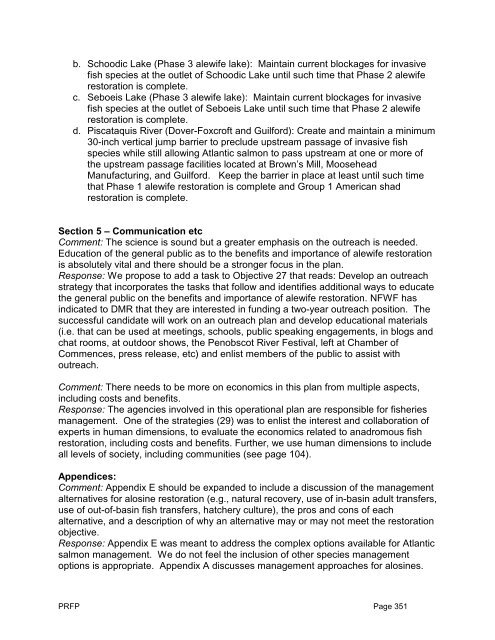Operational Plan for the Restoration of Diadromous Fishes to the ...
Operational Plan for the Restoration of Diadromous Fishes to the ...
Operational Plan for the Restoration of Diadromous Fishes to the ...
Create successful ePaper yourself
Turn your PDF publications into a flip-book with our unique Google optimized e-Paper software.
. Schoodic Lake (Phase 3 alewife lake): Maintain current blockages <strong>for</strong> invasive<br />
fish species at <strong>the</strong> outlet <strong>of</strong> Schoodic Lake until such time that Phase 2 alewife<br />
res<strong>to</strong>ration is complete.<br />
c. Seboeis Lake (Phase 3 alewife lake): Maintain current blockages <strong>for</strong> invasive<br />
fish species at <strong>the</strong> outlet <strong>of</strong> Seboeis Lake until such time that Phase 2 alewife<br />
res<strong>to</strong>ration is complete.<br />
d. Piscataquis River (Dover-Foxcr<strong>of</strong>t and Guil<strong>for</strong>d): Create and maintain a minimum<br />
30-inch vertical jump barrier <strong>to</strong> preclude upstream passage <strong>of</strong> invasive fish<br />
species while still allowing Atlantic salmon <strong>to</strong> pass upstream at one or more <strong>of</strong><br />
<strong>the</strong> upstream passage facilities located at Brown’s Mill, Moosehead<br />
Manufacturing, and Guil<strong>for</strong>d. Keep <strong>the</strong> barrier in place at least until such time<br />
that Phase 1 alewife res<strong>to</strong>ration is complete and Group 1 American shad<br />
res<strong>to</strong>ration is complete.<br />
Section 5 – Communication etc<br />
Comment: The science is sound but a greater emphasis on <strong>the</strong> outreach is needed.<br />
Education <strong>of</strong> <strong>the</strong> general public as <strong>to</strong> <strong>the</strong> benefits and importance <strong>of</strong> alewife res<strong>to</strong>ration<br />
is absolutely vital and <strong>the</strong>re should be a stronger focus in <strong>the</strong> plan.<br />
Response: We propose <strong>to</strong> add a task <strong>to</strong> Objective 27 that reads: Develop an outreach<br />
strategy that incorporates <strong>the</strong> tasks that follow and identifies additional ways <strong>to</strong> educate<br />
<strong>the</strong> general public on <strong>the</strong> benefits and importance <strong>of</strong> alewife res<strong>to</strong>ration. NFWF has<br />
indicated <strong>to</strong> DMR that <strong>the</strong>y are interested in funding a two-year outreach position. The<br />
successful candidate will work on an outreach plan and develop educational materials<br />
(i.e. that can be used at meetings, schools, public speaking engagements, in blogs and<br />
chat rooms, at outdoor shows, <strong>the</strong> Penobscot River Festival, left at Chamber <strong>of</strong><br />
Commences, press release, etc) and enlist members <strong>of</strong> <strong>the</strong> public <strong>to</strong> assist with<br />
outreach.<br />
Comment: There needs <strong>to</strong> be more on economics in this plan from multiple aspects,<br />
including costs and benefits.<br />
Response: The agencies involved in this operational plan are responsible <strong>for</strong> fisheries<br />
management. One <strong>of</strong> <strong>the</strong> strategies (29) was <strong>to</strong> enlist <strong>the</strong> interest and collaboration <strong>of</strong><br />
experts in human dimensions, <strong>to</strong> evaluate <strong>the</strong> economics related <strong>to</strong> anadromous fish<br />
res<strong>to</strong>ration, including costs and benefits. Fur<strong>the</strong>r, we use human dimensions <strong>to</strong> include<br />
all levels <strong>of</strong> society, including communities (see page 104).<br />
Appendices:<br />
Comment: Appendix E should be expanded <strong>to</strong> include a discussion <strong>of</strong> <strong>the</strong> management<br />
alternatives <strong>for</strong> alosine res<strong>to</strong>ration (e.g., natural recovery, use <strong>of</strong> in-basin adult transfers,<br />
use <strong>of</strong> out-<strong>of</strong>-basin fish transfers, hatchery culture), <strong>the</strong> pros and cons <strong>of</strong> each<br />
alternative, and a description <strong>of</strong> why an alternative may or may not meet <strong>the</strong> res<strong>to</strong>ration<br />
objective.<br />
Response: Appendix E was meant <strong>to</strong> address <strong>the</strong> complex options available <strong>for</strong> Atlantic<br />
salmon management. We do not feel <strong>the</strong> inclusion <strong>of</strong> o<strong>the</strong>r species management<br />
options is appropriate. Appendix A discusses management approaches <strong>for</strong> alosines.<br />
PRFP Page 351






